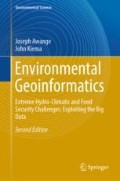Abstract
By convention, data in the real world is deemed to exist in a continuous or analogue form usually in three dimensional space as discussed in Sect. 2.1. Such data needs to be digitized or made discrete before it can be input and processed by a digital computer. A GIS database can be viewed as an abstraction of reality. To convert object features observed or measured in the real world into the digital realm in a GIS database it is necessary to structure the data appropriately. Four (4) different generic types of primitive object features can be distinguished, namely: point features (0-D), line features (1-D), area features/polygons (2-D), and surface features (3-D). Incidentally, when surface features are captured in a discrete or non-continuous manner, this is then referred to as 2.5D. In general, an object feature is defined by three (3) properties in GIS, namely: position, attributes and relationship with other features referred to as topology.
The sciences do not try to explain, they hardly even try to interpret, they mainly make models. By a model is meant a mathematical construct which, with the addition of certain verbal interpretations, describes observed phenomena. The justification of such a mathematical construct is solely and precisely that it is expected to work - that is, correctly to describe phenomena from a reasonably wide area.
—John von Neumann (1903–1956)
Access this chapter
Tax calculation will be finalised at checkout
Purchases are for personal use only
References
Murai S (1999) GIS work book: fundamental and technical courses, vols 1 & 2. National Space Development Agency
ESRI (2005) GIS topology: an ESRI white paper, p 14
Bishr Y (1998) Overcoming the semantic and other barriers to GIS interoperability. Int J Geogr Inf Sci 12(4):299–314. https://doi.org/10.1080/136588198241806
Mena JB (2003) State of the art on automatic road extraction for GIS update: a novel classification. Pattern Recogn Lett 24(16):3037–3058
Stilla U, Michaelsen E (1997) Semantic modelling of man-made objects by production nets. Automatic extraction of man-made objects from aerial and space images (II). Birkhäuser Verlag Basel, Monte Verita, pp 43–65
Author information
Authors and Affiliations
Corresponding author
Rights and permissions
Copyright information
© 2019 Springer Nature Switzerland AG
About this chapter
Cite this chapter
Awange, J., Kiema, J. (2019). Data Models and Structure. In: Environmental Geoinformatics. Environmental Science and Engineering(). Springer, Cham. https://doi.org/10.1007/978-3-030-03017-9_15
Download citation
DOI: https://doi.org/10.1007/978-3-030-03017-9_15
Published:
Publisher Name: Springer, Cham
Print ISBN: 978-3-030-03016-2
Online ISBN: 978-3-030-03017-9
eBook Packages: Earth and Environmental ScienceEarth and Environmental Science (R0)

